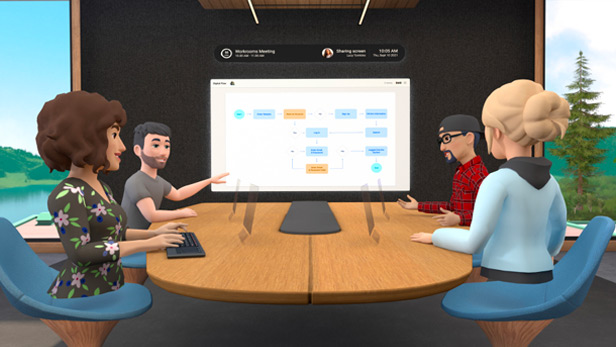August 20, 2021
Facebook Launches VR Meetings, But Why?
‘Workrooms’ allows the distributed workforce to come together in a virtual conference room, but will the high-tech collaboration solution find mass appeal?
If you hate Zoom, you’re sure to despise Facebook’s new solution for better remote collaboration. Horizon Workrooms allows users with an Oculus Quest 2 VR headset to “meet” at a virtual conference room, interacting via a cartoonish avatar. It’s sort of like embodying your own Bitmoji if it were cut in half, with the torso just hovering above a virtual desk chair.

Or as some on Twitter have dubbed it: “Animal Crossing for work meetings.”
Henceforth, Facebook’s Horizon Workrooms shall only be referred to as ANIMAL CROSSING FOR WORK MEETINGS https://t.co/EtTNjwbKN0
— Rob Sheridan (@rob_sheridan) August 19, 2021
The Workrooms app is free to use (though an Oculus headset will set you back a few hundred bucks). Up to 16 people on VR headsets can gather virtually around a sturdy pixel-board conference table. The app allows 50 people in the meeting, but the others would join as video callers who appear on a flat screen in the virtual meeting room. Participants wearing VR headsets can use their hands to gesture during meetings, and their avatars’ mouths also move while they speak. The space includes a virtual whiteboard that allows people to share pictures or make presentations.
“The pandemic in the last 18 months has only given us greater confidence in the importance of this as a technology,” Andrew Bosworth, vice president of Facebook Reality Labs, said during a presentation to announce the app, according to CNN Business.
Facebook says it’s been using the Workrooms technology internally for the last year. Calling it their “flagship collaboration experience,” the company says it’s a melding of several technologies, including mixed-reality desk and keyboard tracking, hand tracking, remote desktop streaming, videoconferencing integration, spatial audio and the aforementioned avatars. “We think it’s one of the best ways to work if you can’t be physically together,” Facebook wrote in its announcement of the new technology.
In addition to the high-tech hand tracking features, the app also offers more traditional meeting features, like file sharing, calendar integration, chat and meeting notes.
As might be expected, there are still a few kinks to work out. (CNN reported that in the middle of Bosworth’s virtual pitch, his avatar froze mid-sentence because the Facebook exec had been disconnected.) Plus, convincing businesses to invest in pricy VR headsets could be an uphill battle. And the hardware itself is not conducive to long meetings since the headset itself weighs about a pound and can feel unwieldy over long periods. Bosworth told CNN that he expects the app to be used for about 30 minutes at a time. (Actually, now that I think about it, maybe technology that forces meetings to be shorter is a good thing.)
I’ve long been an advocate of remote work, and I’m always intrigued by the possibilities of new technology, but there’s something about Workrooms that falls a little flat for me. The last time I tried virtual reality was at CES a few years ago. A Peloton-like exercise equipment company had journalists don headsets and get on one of their stationary bikes. Instead of merely cycling, however, riders were transformed into winged horses that scored points by eating apples floating in the sky. It was certainly more fun than giving a thumbs up in a fake boardroom, but I’ve never really had the urge to go out and buy a VR bike of my own. And I have a feeling that Facebook’s latest foray into the virtual world will remain niche as well.
In a poll I posted recently on my LinkedIn page (very scientific, I know), feelings about meeting via virtual reality have been mixed. Gloria LaFont, president and owner of Action Marketing Co., was taking a wait-and-see approach. “Although I’m fully immersed in digital marketing and communication tools, I don’t jump into the newest thing,” she wrote. “Especially with Facebook, I’ve seen so many features come and go and early adopters left scrambling when they remove the features.”
Javier Melendez, national sales executive for Walker-Clay Inc. (asi/354530), said he loved the idea, but not Facebook being the developer. He pointed out that VR technology could be a good fit for hybrid conferences in the future.
The metaverse as a concept – a space where people can meet to play, work and socialize virtually a la Ready Player One – continues to hold appeal for tech firms. So, I wouldn’t be surprised to see Facebook push hard to make Workrooms happen. For my part, I think I’ll wait until I can turn my avatar into a mythological creature. How fun would quarterly meetings be if you had wings?
